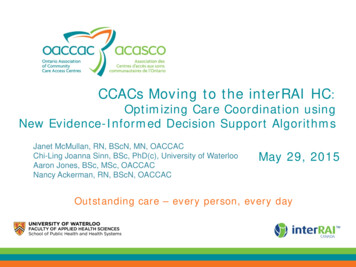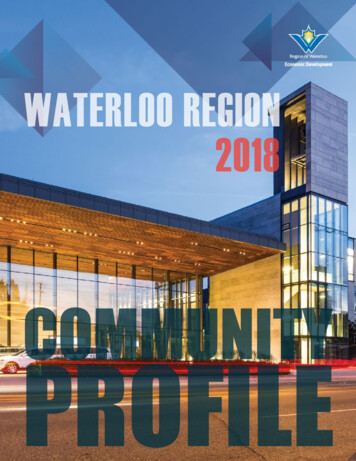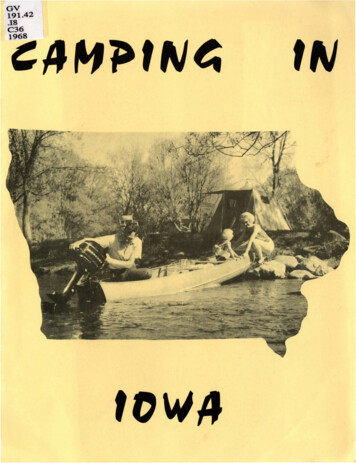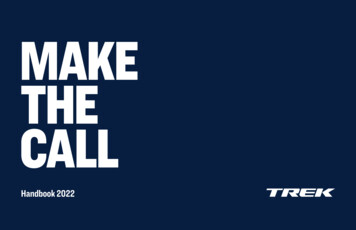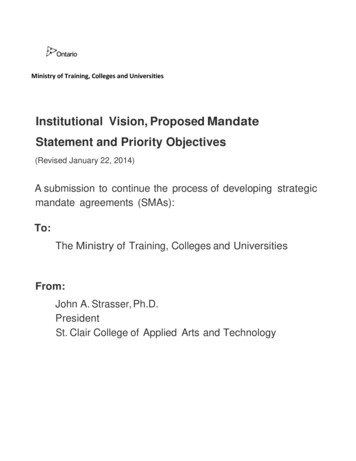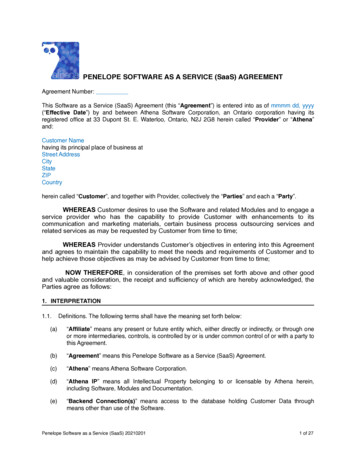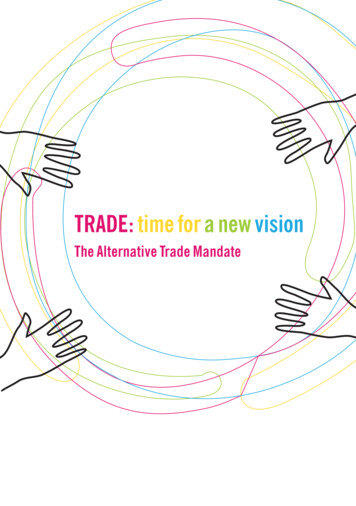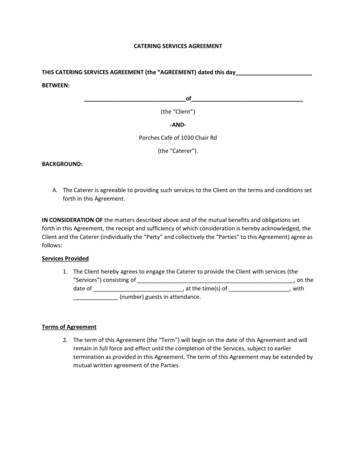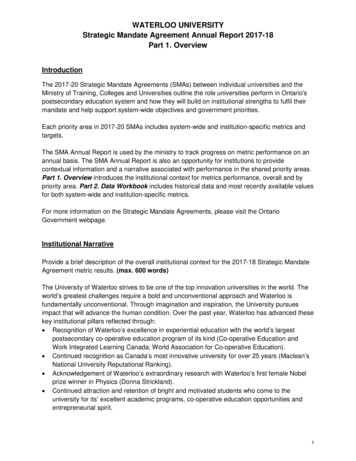
Transcription
WATERLOO UNIVERSITYStrategic Mandate Agreement Annual Report 2017-18Part 1. OverviewIntroductionThe 2017-20 Strategic Mandate Agreements (SMAs) between individual universities and theMinistry of Training, Colleges and Universities outline the role universities perform in Ontario'spostsecondary education system and how they will build on institutional strengths to fulfil theirmandate and help support system-wide objectives and government priorities.Each priority area in 2017-20 SMAs includes system-wide and institution-specific metrics andtargets.The SMA Annual Report is used by the ministry to track progress on metric performance on anannual basis. The SMA Annual Report is also an opportunity for institutions to providecontextual information and a narrative associated with performance in the shared priority areas.Part 1. Overview introduces the institutional context for metrics performance, overall and bypriority area. Part 2. Data Workbook includes historical data and most recently available valuesfor both system-wide and institution-specific metrics.For more information on the Strategic Mandate Agreements, please visit the OntarioGovernment webpage.Institutional NarrativeProvide a brief description of the overall institutional context for the 2017-18 Strategic MandateAgreement metric results. (max. 600 words)The University of Waterloo strives to be one of the top innovation universities in the world. Theworld’s greatest challenges require a bold and unconventional approach and Waterloo isfundamentally unconventional. Through imagination and inspiration, the University pursuesimpact that will advance the human condition. Over the past year, Waterloo has advanced thesekey institutional pillars reflected through: Recognition of Waterloo’s excellence in experiential education with the world’s largestpostsecondary co-operative education program of its kind (Co-operative Education andWork Integrated Learning Canada; World Association for Co-operative Education). Continued recognition as Canada’s most innovative university for over 25 years (Maclean’sNational University Reputational Ranking). Acknowledgement of Waterloo’s extraordinary research with Waterloo’s first female Nobelprize winner in Physics (Donna Strickland). Continued attraction and retention of bright and motivated students who come to theuniversity for its’ excellent academic programs, co-operative education opportunities andentrepreneurial spirit.1
WATERLOO UNIVERSITYStrategic Mandate Agreement Annual Report 2017-18Part 1. Overview Continued graduation of workplace-ready students, with up to two years of workplaceexperience. Compared to the provincial average, Waterloo co-op graduates are more likelythan other university graduates to be employed six months and two years after graduation(Ontario University Graduate Survey). They earn more than their university-educated peersand are much more likely to be hired in positions related to their field of study (OntarioUniversity Graduate Survey).The University of Waterloo made significant progress on achieving its institutional goals asoutlined in its 2013-2018 Strategic Plan by building on its established success in experientialand entrepreneurial approaches to education, research and connection to industry and society.Between 2013-2018, Waterloo has: Maintained one of the highest year one-to-two retention rates within the U15 (93.9%) in2016. This is a testament to the institutions’ efforts in providing a robust and variedstudent experience. Increased enrolment in co-op programs by 17.1% to over 21K students in 2017/18,demonstrating increasing demand for the learning experience Waterloo offers. Supported student and recent alumni ventures in obtaining over 960M in investmentfunding, showcasing Waterloo’s contribution to building partnerships with business andindustry. Increased total sponsored research funding by 24% to 224.3M, highlighting Waterloo’sstrength in producing high quality research. Fostered a welcoming environment where students can access postsecondaryeducation by providing over 10,000 university participants with training in equity,diversity and inclusivity.With the completion of the 2013-2018 Strategic Plan in spring 2018, Waterloo embarked on anevidence-based, consultative and engaging planning process to chart a path for its 2020-2025Strategic Plan. This comprehensive and robust plan will identify an updated vision and strategicgoals and objectives for the institution. This process will ensure that Waterloo continues todifferentiate itself from its peers in preparing highly qualified, skilled graduates ready to enter theworkforce and solve the world’s challenges, propelling innovation and job creation both at homeand around the world.Priority AreasProvide trends and key outcomes for the 2017-18 Strategic Mandate Agreement metrics included withineach of the five priority areas. (max. 200 words per priority area).1. Student ExperienceThis priority area captures institutional strengths in improving student experience, outcomes andsuccess, and recognizes institutions for measuring the broader learning environment, such ascontinuity of learning pathways, retention, student satisfaction, co-curricular activities andrecords, career preparedness and student services and supports.2
WATERLOO UNIVERSITYStrategic Mandate Agreement Annual Report 2017-18Part 1. OverviewThe University of Waterloo is continually improving the student experience and optimizingstudent success. In 2017-2018 Waterloo increased efforts to understand the studentexperience; made critical service, space and physical plant improvements; and identified newand vital student supports, building a better experience and a stronger sense of communityconnection for students.The new Student Services Centre (“the Centre”) is a “one-stop” student services hub,centralizing core student services in a welcoming space through self-serve and staffed servicesthat are fully integrated with web-based services. Initiated in 2016 and with the physical spaceopened in December 2018, the real advantage of the Centre is the student-focused, integratedand robust student service delivery system with numerous opportunities for further serviceintegration.The President’s Advisory Committee on Student Mental Health was created in 2017 to addressstudent mental health within the larger societal context. Students, faculty, and universityadministration came together to discuss and identify vital issues and necessary improvementsin student mental health and supports. The Committee’s report, released in 2018, has 36recommendations for action in five areas: academic, mental health experts, student services,student experience, and community partners. Implementation has begun in earnest incollaboration with student leaders.2. Innovation in Teaching and Learning ExcellenceThis priority area focuses on innovative efforts including pedagogical approaches, programdelivery and student services that contribute to a highly skilled workforce and ensure positivestudent outcomes. It captures institutional strengths in delivering high-quality learningexperiences such as experiential, entrepreneurial, personalized and digital learning, and studentcompetencies that improve employability.The University of Waterloo offers one of the world’s largest and most comprehensive cooperative education programs. Almost three-quarters (72.5%) of incoming undergraduatestudents at Waterloo are enrolled in co-op. Co-op students enjoy a 98.5% employment rate.Waterloo connects with over 7,000 active employers globally. In 2017-18 Waterloo introducedthe EDGE certificate, offering non co-op students extraordinary experiential programming.These work experience and skills development opportunities ensure that Waterloo graduatesare uniquely prepared to tackle the challenges of the 21st century.Waterloo develops resources to support teaching and learning with an emphasis oncommunication skills and incentives for teaching excellence. Waterloo’s Centre for TeachingExcellence (CTE) underwent an external review in 2017, which confirmed its quality and valueand identified areas for enhancement. The National Educational Developers Caucus accreditedCTE’s graduate student’s Fundamentals of University Teaching Program, validating its designand rigour.3
WATERLOO UNIVERSITYStrategic Mandate Agreement Annual Report 2017-18Part 1. OverviewWaterloo also demonstrates national leadership in high quality online programming through theCentre of Extended Learning (CEL). CEL supports accessibility by making student resourcesavailable digitally, providing substantive cost savings for students. This included makingmaterials for a large first-year chemistry course available for free online, and adopting a freeopen textbook in the Psychology 101 online course.3. Access and EquityThis priority area recognizes institutions for their efforts in improving postsecondary educationequity and access, and for creating opportunities that can include multiple entrance pathwaysand flexible policies and programming, with the focus on students who, without interventionsand support, might not otherwise participate in postsecondary education.Waterloo is committed to creating an equitable and engaging place to live, work and study. In2018 Waterloo began a series of consultations on equity-related topics including sexual andgender diversity, racialized students and other marginalized groups. This process will continue,ensuring that student voices are heard and addressed. Waterloo has also begun work on theuniversity’s Indigenization strategy. Since 2013 over 10,000 faculty, students and staff haveattended equity workshops. Waterloo is also implementing a multi-year Accessibility Plan toimprove the University’s accessibility for persons with disabilities in accordance with theAccessibility for Ontarians with Disabilities Act standards.Data sources used for several access and equity metrics (including first generation students andIndigenous status) are optional self-identification questions posed to students. Data collected ona basis of voluntary self-declarations are not ideal, providing inconsistent and unreliable results,and should be used with caution. This is illustrated by Waterloo’s first generation students’ data.In 2015-16, Waterloo had 2,534 first generation students, in 2016-17 1,603, and in 2017-182,321. This wide fluctuation is less likely to indicate real changes in the makeup of Waterloo’sstudent body, and more likely the result of volatile data sources with a wide margin of error.4. Research Excellence and ImpactThis priority area captures institutional strengths in producing high-quality research on thecontinuum of fundamental and applied research through activity that further raises Ontario'sprofile as a globally recognized research and innovation hub. It also acknowledges thatresearch capacity is strongly linked with graduate education.At Waterloo, curiosity is fueled by a passion to inform – and transform – the world. Through itsresearch, the University pushes the frontiers of knowledge in all of its fields of endeavor andmakes a vital difference on a global scale. In 2018 this was recognized through Waterlooprofessor Donna Strickland’s award of the Nobel Prize in Physics. Waterloo has been namedthe top research university of the year in the comprehensive category by Research InfoSourceevery year since 2013 and has been #1 in SSHRC funding per faculty member in four out of fiveyears between 2013-2017 according to Maclean’s. In 2017/18, approximately 30% of Waterloo’s4
WATERLOO UNIVERSITYStrategic Mandate Agreement Annual Report 2017-18Part 1. Overviewresearch funding was attributable to industry partnerships. The university also exceeded itsstrategic objective for total sponsored research funding in 2018, increasing 24.0% since 2013 to 224.3M.Waterloo’s research impact can also be seen in the startup arena. This includes a cumulativeinvestment over the last year of 39.8M in WatCo startups; four new startups created in the pastyear based on Waterloo faculty member intellectual property; and the Accelerator CentreJumpstart program which spawned 53 new companies since 2012, with more than 195M infollow-on investment, and created more than 350 new jobs.5. Innovation, Economic Development and Community EngagementThis priority area recognizes the unique role institutions play in contributing to their communitiesand to economic development, as well as to building dynamic partnerships with business,industry, community members and other colleges and universities. It focuses on regionalclusters, customized training, entrepreneurial activities, jobs, community revitalization efforts,international collaborations, students, partnerships with Indigenous Institutes and a program mixthat meets needs locally, regionally and beyond.The University of Waterloo has a uniquely entrepreneurial spirit. Students and faculty areimmersed in an ecosystem, bringing world-changing ideas to the global marketplace. Waterloonurtures, leverages and optimizes this ecosystem by supporting startups, increasing studentengagement, and expanding exposure to entrepreneurial activity. Waterloo’s leadership increating global technological leaders and start up founders was recognized by PitchBook (21st inthe world in 2018 for universities producing entrepreneurs), and Startup Genome, whichidentified the University as an anchor in the Waterloo-Toronto corridor.Waterloo’s Velocity Program, Canada’s most productive incubator, offers coaching, mentoring,and physical space and engages over 3,000 students each term through its events. Velocitycompanies have created more than 2,200 jobs and raised more than 800M in privateinvestment. Velocity has supported 28 high-potential startups in Waterloo Region get access toworld renowned accelerators.Waterloo’s Accelerator Centre (AC), an award-winning startup accelerator, has worked withover 500 companies in its 12 year history. AC programming graduates have a combined 84 percent success rate after five years, with significant economic impact. AC clients and graduatecompanies have generated more than 3B in corporate value, created 3,000 jobs (including 800co-op placements) and received more than 600M in funding.5
WATERLOO UNIVERSITYStrategic Mandate Agreement Annual Report 2017-18Part 1. OverviewAttestationThe University of Waterloo confirms that all information being submitted to the ministryas part of the 2017-18 SMA annual report is accurate and has received approval from theUniversity President.Please complete the contact information below.Institutional Contact Name:Telephone:Email:Completion Date:Website address for postingministry approved report:Jana Carson519-888-4567 ext. 38611jccarson@uwaterloo.caJanuary 21, nning/reports/strategic-mandate-agreement6
University of Waterloo SMA2 Annual Report 2017-18 Part 2System-Wide MetricsID8Priority AreaStudent Experience34Student Experience98Student Experience71Student Experience5241Innovation in Teaching andLearning ExcellenceInnovation in Teaching andLearning Excellence35Innovation in Teaching andLearning Excellence103Access and Equity104Access and Equity105Access and Equity106Access and Equity36Access and Equity84107Access and EquityAccess and EquityMetric NameYear 1 to Year 2 retention rateProportion of senior-year students with two High-ImpactPractices (HIPs)Average number of High Impact Practices (HIPs) perfourth-year studentProportion of operating expenses on student services,net of student assistanceGraduation 0.6%Proportion of programs with explicit curriculum mapsand articulation of learning outcomes56.0%Composite score on NSSE question related to students’perceived gains in higher order learning outcomesNumber of first generation students enrolled atinstitutionNumber of students with disabilities enrolled atinstitutionNumber of Indigenous students enrolled at institutionNumber of French-language students enrolled atinstitutionShare of OSAP recipients at an institution relative to itstotal number of eligible studentsNumber of transfer applicationsNumber of transfer 437344076148Research Excellence and Impact Number of papers per faculty member2.250Research Excellence and Impact Number of citations per paper11.897Research Excellence and Impact CIHR funding - share to total Ontario universities1.8%1.9%96Research Excellence and Impact SSHRC funding - share to total Ontario universities7.8%7.8%95Research Excellence and Impact NSERC funding - share to total Ontario universities15.3%15.5%94Research Excellence and Impact8.2%8.3%8711Innovation, EconomicDevelopment and CommunityEngagementInnovation, EconomicDevelopment and CommunityEngagementInnovation, EconomicDevelopment and CommunityEngagementTotal Tri-Council funding - share to total OntariouniversitiesOf those graduates who are working full-time, whatproportion are working in related jobs93.5%92.9%91.7%92.5%Graduate employment rate6 months87.2%87.1%86.5%89.6%Graduate employment rate2yr94.1%95.3%95.9%95.3%Grey-out cells: data not available7
Institution-Specific Metrics#Priority AreaMetric NameObjective of MetricFrequencyAnnual1 Student ExperienceProportion of operating expenditures on studentscholarships and bursariesMeasures Waterloo's commitment tosupporting our students financially,recognizing academic achievementand addressing financial need.2 Student ExperienceNumber of student international experiencesMeasures Waterloo's commitment tointernationalization3 Student ExperiencePercentage of graduate students who wouldrecommend WaterlooInnovation in4 Teaching and LearningExcellenceInnovation in5 Teaching and LearningExcellenceInnovation in6 Teaching and 0Every ThreeYears77.5%Percentage of undergraduate students enrolled in co- Maintain Waterloo's leading role in coop programsoperative education internationallyAnnual65.0%66.3%67.1%67.7%Total annual earnings by co-op studentsAnnual 206.3 M 225.9 M 240.5 M 261.4 MPercentage of students rated between 'very good'and 'outstanding' in work term performancesAnnual91.3%91.9%92.8%93.4%7 Access and EquityPercentage of undergraduate courses offered in moreMeasures flexibility and range ofthan one term, or in more than one modecourse options available to studentsAnnual31.1%31.6%31.2%32.0%8 Access and EquityAverage OSAP debt of graduating Waterloo studentsAnnual18,42719,07520,07521,5289 Access and EquityFemale participation in undergraduate Engineeringand Mathematics arch Excellenceand Impact (Univ)Proportion of publications with international coauthorsAnnual11Research Excellenceand Impact (Univ)Industry-leveraged funding dollarsAnnual 56.2M 54.8M 62.3M 66.1MInnovation, Economic Number of current student and recent-alumnicreated ventures assisted by UW entrepreneurship12 Development andCommunity ImpactprogramsAnnual173161210229Innovation, Economic13 Development andSurvival rates of Velocity venturesCommunity ImpactAnnual90.7%87.0%89.0%91.0%Innovation, EconomicInvestment in current student and recent alumni-led14 Development andventuresCommunity ImpactAnnual 188,800,000 265,900,000 200,500,000 204,700,00038.3%42.6%Grey-out cells: data not available8
Appendix 1. Data inputs required for calculation of selected system-wide metricsMetric IDMetric Name36Share of OSAP recipients at aninstitution relative to its totalnumber of eligible students71Proportion of operating expenses onstudent servicesTable 6 COFO Financial ReportData inputs for calculating metrics2016-172017-18Total OSAP Award Recipients15,58617,328Total Eligible Student Headcount22,79423,135Total operating expenses (000s)(Cell L36) 675,827 731,033Student service expenses (000s)(Cell G36) 88,715 105,693Scholarships, bursaries (000s)(Cell G28) 57,220 69,561Data inputs for calculating metrics2014-152015-162016-17Total(14/15 - 16/17)3yr avg.(14/15 - 16/17)University funding value 5,769,473 5,289,421 6,574,025 17,632,919 5,877,640Total Ontario funding value 304,962,320 304,827,533 337,697,915 947,487,768 315,829,256University funding value 5,323,348 5,259,568 5,446,017 16,028,933 5,342,978Total Ontario funding value 64,980,841 66,781,141 73,737,728 205,499,710 68,499,903University funding value 43,872,037 41,208,738 45,982,492 131,063,268 43,687,756Total Ontario funding value 276,845,451 273,490,047 293,234,732 843,570,230 281,190,077University funding value 54,964,858 51,757,727 58,002,534 164,725,119 54,908,373Total Ontario funding value 646,788,611 645,098,721 704,670,375 1,996,557,708 665,519,23620112012201320142015Research Funding DataMetric IDMetric Name97CIHR funding - Share to total ofOntario Universities969594SSHRC funding - Share to total ofOntario UniversitiesNSERC funding - Share to total ofOntario UniversitiesTri-Council funding - Share to total ofOntario UniversitiesBibliometrics Data (as of Nov.2017 for the time period 2011-2015)Metric IDMetric NameData inputs Counts for calculating metrics50Number of citations per paperNumber of er of papers2,3212,5082,7212,9833,09213,62548Number of papers per facultymemberNumber of faculty membersTotal(2011-2015)5yr avg.(2011-2015)2,7251,2399
Appendix 2. University Metrics - DictionaryIDMetric Name8Year 1 to Year 2retention rate34DescriptionPercentage of first-time, full-timeundergraduate university studentswho commenced their study in agiven Fall term and have continued tostudy at the same institution in thenext Fall termSourceReporting PeriodNotesConsortium forStudent RetentionData Exchange(CSRDE)Academic year, returning cohort. E.g., the 2016- Based on cohort analysis by CSRDE and reported by17 data value reflects students who enrolled in universities through SMA Annual Reports. Compatible withFall 2015 and returned to the institution in Fall CSRDE graduation rate2016Proportion of fourth- Percentage of students whoyear students withparticipated in two or more of the sixtwo or more HighHigh Impact Practices (HIPs) asImpact Practicesidentified in NSSE - service learning,(HIPs) (1)learning community, research with afaculty member, internship or fieldexperience, study abroad andculminating senior experienceNational Report on“Customizable ItemsSelector”, NationalSurvey of StudentEngagement (NSSE)Academic year when National Survey of StudentEngagement (NSSE) is administered; e.g., datafor 2014 NSSE is included under 2014-15. MostOntario universities participate in the surveyevery three years and provide data only forthese years (2014 and 2017)Participation includes the percentage of students whoresponded "Done or in progress" for five HIPs (Q11) and atleast "Some" of courses included a community-basedproject for service learning (Q12)98Average number ofHigh ImpactPractices (HIPs) perfourth-year student(1)Average number of High-ImpactPractices (HIPs) of the six HIPsidentified in NSSE per respondentNational Report on“Customizable ItemsSelector”, NationalSurvey of StudentEngagement (NSSE)Academic year when National Survey of StudentEngagement (NSSE) is administered; e.g., datafor 2014 NSSE is included under 2014-15. MostOntario universities participate in the surveyevery three years and provide data only forthese years (2014 and 2017)Participation includes the percentage of students whoresponded "Done or in progress" for five HIPs (Q11) and atleast "Some" of courses included a community-basedproject for service learning (Q12)71Proportion ofoperating expenseson student servicesPercentage of total student services Council of Ontarioexpenses, excluding scholarships and Finance Officersbursaries, in total operating expenses (COFO)in a given fiscal year (consolidatedvalues including affiliates whereapplicable)Fiscal YearProportion of operating expenses on student services iscalculated as total student services expenses (Cell G36)minus scholarships, bursaries etc. (Cell 28) divided by totaloperating expenses (Cell L36) as per Table 6, COFO FinancialReport of Ontario Universities52Graduation ratePercentage of first-time, full-timeundergraduate university studentswho commenced their study in agiven Fall term and graduated fromthe same institution within 6 yearsConsortium forStudent RetentionData Exchange(CSRDE)Academic year, graduating cohort: e.g. 2015-16 Based on cohort analysis by CSRDE and reported bydata value reflects students who enrolled in Fall universities through SMA Annual Reports. Compatible with2009 and graduated within six years, before or CSRDE retention ratein calendar year 201541Proportion ofprograms withexplicit curriculummaps andarticulation oflearning outcomesProportion of programs with explicitcurriculum maps with articulation oflearning outcomesInstitutional dataAcademic yearAs part of the Quality Assurance process introduced in 2010,all academic programs undergoing cyclical review arerequired to articulate learning outcomes in relation toundergraduate and graduate degree-level expectations.Curriculum mapping involves the articulation of learningoutcomes at the course level.35Composite score on Students' perceived gains inNSSE questionknowledge, skills and personalrelated to fourthdevelopmentyear studentsperceived gains inhigher order learningoutcomesNational Survey ofStudent Engagement(NSSE)Academic year when National Survey of StudentEngagement (NSSE) is administered; e.g., datafor 2014 NSSE is included under 2014-15. MostOntario universities participate in the surveyevery three years and provide data only forthese years (2014 and 2017)Skills gains are measured as a simple sum of NSSE meansfor ten areas (Q17a-Q17j) including effective writing andspeaking, critical thinking, numerical analysis, work-relatedknowledge and skills, team-work, problem-solving, being aninformed and active citizen, understanding people of otherbackgrounds103Number of firstTotal number of full-time firstgeneration students generation students enrolled atenrolled atinstitutioninstitutionEnrolment dataAcademic yearFirst generation student is a student whoseparent(s)/guardian(s) has/have not attended apostsecondary institution. If a sibling of the student hasattended a postsecondary institution, but theparent(s)/guardian(s) have not, the student is stillconsidered a first generation student104Number of students Total number of students withwith disabilitiesdisabilities registered with the Officeenrolled atfor Students with DisabilitiesinstitutionTable 1 of theAcademic yearinstitution's annualreport to the ministryfor the AccessibilityFund for Students withDisabilities (AFSD);enrolment dataNumber of students with disabilities for 2016-17 year isbased on the AFSD reports. Please review and update wherenecessary to align with previous values10
IDMetric NameDescriptionSourceReporting PeriodNotes105Number ofTotal number of full-time IndigenousIndigenous students students enrolled at institutionenrolled atinstitutionEnrolment dataAcademic yearIndigenous is a collective name for the original people ofNorth America and their descendants. The CanadianConstitution, Constitution Act 1982, recognizes three groupsof Indigenous peoples - Indians (First Nation), Métis andInuit. These are three separate peoples with uniqueheritages, language, cultural practices and spiritual beliefs106Number of Frenchlanguage studentsenrolled atinstitutionTotal number of full-time Frenchlanguage students enrolled atinstitutionEnrolment dataAcademic yearA student is considered a French-language student if he orshe meets at least one of the following criteria of: Thestudent’s mother tongue is French; The principal languageof correspondence with the student is French; The studentwas previously enrolled in a French-language educationinstitution; The student was enrolled in a postsecondaryprogram delivered partially in French36Share of OSAPrecipients at aninstitution relative toits total number ofeligible studentsFull-time Ontario Student FinancialAid (OSAP) recipients at an institutionas a share of its total number of fulltime grant eligible enrolmentOSAP recipients:MTCU; Full-time granteligible enrolment:Institutional data84Number of transferapplicationsFull-time transfer students in the fallof the first-year of a universityprogram, who have applied touniversity and have identified onapplications to Ontario UniversityApplications Centre (OUAC)Ontario UniversityApplications Centre(OUAC) reports andreported byuniversities throughSMA Annual ReportsAcademic year, 2016-17 and 2017-18. OSAPacademic year starts at August 1, with academicyear end data available at the end of August thefollowing year. Full-time enrolment: fundingeligible November 1st headcount ofundergraduate and graduate students with 60%Load (0.3FTE) or greaterAcademic year of application and registrationThe number of OSAP awards includes any undergraduateand graduate student who has applied for full-time OSAPassistance and was issued funding.Note: In 2017-18 the definition was adjusted to reflect thenumber of recipients that were issued awards (rather thanthe number of applicants eligible for awards) and to excludethe double counting of applicants.Metric does not reflect all transfers as it excludes transferstudents who apply directly to university and includes onlystudents who applied through OUAC in the fall of the 1styear of university from publicly-assisted colleges anduniversities107Number of transferregistrationsFull-time transfer students registeredin the fall of the first-year of auniversity program, who haveapplied to university and haveidentified on applications to OntarioUniversity Applications Centre (OUAC)Ontario UniversityApplications Centre(OUAC) reports andreported byuniver
investment over the last year of 39.8M in WatCo startups; four new startups created in the past year based on Waterloo faculty member intellectual property; and the Accelerator Centre Jumpstart program which spawned 53 new companies since 2012, with more than 195M in follow-on investment, and created more than 350 new jobs. 5.
